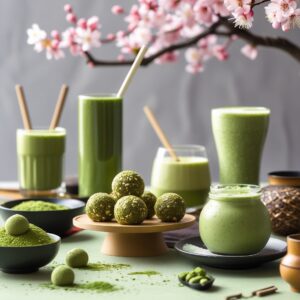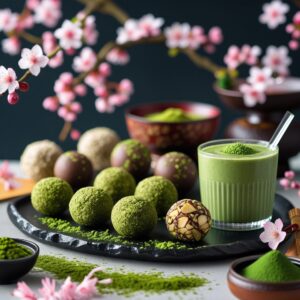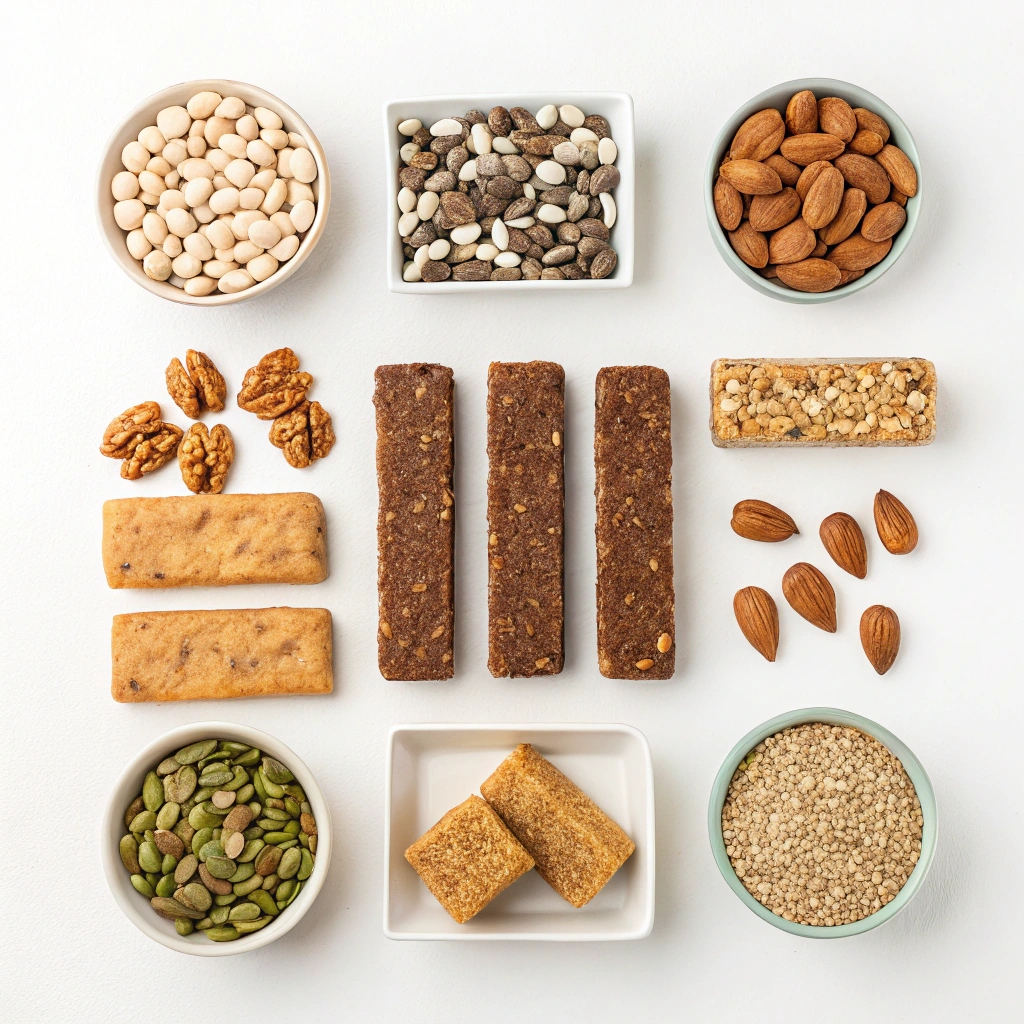Are you tired of feeling sluggish after a meal?
You’ve tried every protein-packed snack, from energy bars to Greek yogurt…
But are those ingredients doing more harm than good?
Discover the game-changing power of matcha powder – a finely ground Japanese superfood that’s been fueling champions for centuries.
From weight loss to glowing skin, matcha has got it all! But how? And what makes this green tea so uniquely effective?
Get ready to unlock your body’s full potential with matcha, and experience a world of radiant energy and vitality.
The History and Science Behind Matcha’s Protein Properties
Matcha, a finely ground Japanese green tea, has been around for centuries. Its unique properties have captivated many, making it more than just a tasty addition to your protein snack routine.
The Science Behind Matcha’s Protein Power
In 1874 L-theanine was isolated from matcha by French chemist Claude Sultanas. And if you think of matcha as a superfood, then its reputation precedes it. With about three times more antioxidants than green tea leaves, and all nine essential amino acids that are needed for protein synthesis.
The first time the effects of L-theanine were studied was in 1949 by Dr Kondo Tanaka at Kyushu University. His research revealed that matcha contained a compound called caffeine anhydrous, which is also found in coffee beans but at much lower levels than its caffeine content. In fact the amount of l- theanin present is one-fourth that of coffee.
The amino acid glutamine can be extracted from many plant-based foods and even animal-derived proteins like eggs or fish. But matcha stands out due to its high L-glutamate content which contains about four times more than green tea leaves. This could potentially improve muscle recovery after exercise, making it a great addition for post-workout snacks.
So what is the key here? Well you need not overthink this – all that matters is whether or not matcha can provide any benefits in your protein snack routine
Unleashing the Power of L-Theanine in Your Snack Routine
Introducing Matcha Bliss: A Game-Changing Superfood for Your Protein Snack Routine
Imagine fueling your body with a natural energy boost that lasts, without the jitters or crash. This is exactly what matcha-powered protein snacks can offer. By combining two of nature’s most potent ingredients – caffeine and L-theanine from green tea – you’ll unlock an explosion of sustained vitality and mental clarity.
L-Theanine: The Ultimate Relaxation Catalyst
Matcha contains a unique amino acid called L-theanine, which has been scientifically shown to promote relaxation and reduce mind-wandering. When paired with matcha’s caffeine content, the result is an unparalleled synergy that enhances focus and alertness without sacrificing calmness or stability. This perfect balance makes Matcha Bliss an ideal snack for exercise enthusiasts looking to optimize their performance.
The Science Behind the Snack: Caffeine & L-Theanine Harmony
Studies have shown that the combination of matcha’s L-theanine and caffeine can help delay fatigue and improve endurance during intense workouts. For example, a study published in the Journal of Strength and Conditioning Research found that consuming green tea extract (which contains both caffeine and L-theanine) improved exercise performance by increasing muscle contraction force. This synergy makes Matcha Bliss an excellent addition to your snack routine.
Boost Your Fitness with Matcha-Infused Protein Snacks
Imagine having a smooth, sustained energy boost that fuels you through workouts and keeps you going even when the going gets tough. That’s what matcha-based protein snacks can deliver. By fueling up on these energizing bites during or after exercise, you’ll experience improved endurance and enhanced overall performance.
Post-Workout Recovery with Matcha Bliss
After a grueling gym session or intense workout, your body needs replenishment to repair and rebuild tissues. This is where matcha-powered protein snacks come in – providing essential amino acids like glutamine and arginine that help fuel muscle recovery. By incorporating these snacks into your post-workout routine, you’ll be able to recover faster, train harder.
The Science Behind the Benefits: L-Theanine for Mental Clarity
But what exactly does Matcha Bliss do for your mental health? The answer lies in L-theanine’s ability to promote relaxation and reduce mind-wandering. This unique amino acid has been shown to increase alpha brain waves associated with calmness, reducing symptoms of anxiety and stress while improving focus and concentration. With matcha as a snack, you’ll be able to tackle even the most demanding tasks with clarity and poise.
The bottom line? Matcha Bliss is more than just an energy-boosting superfood – it’s a tool for unlocking optimal performance, mental clarity, and overall well-being. By harnessing its unique blend of caffeine and L-theanine, you’ll be able to fuel your body and mind like never before.
How Green Tea-Based Proteins Can Improve Exercise Performance
For athletes looking to gain an edge over their competitors, research into green tea-based protein supplements has sparked excitement. This is because these innovative products combine the antioxidant properties of green tea with high-quality proteins that have been extensively studied.
The key factor in unlocking the benefits of green tea-based proteins lies in their unique combination of catechins – polyphenols known for their high antioxidant activity and potential to improve blood flow. Imagine your body as a finely tuned machine, where enhanced circulation can mean all the difference between winning and losing a race. Research has shown that catechins in these supplements increase nitric oxide production, leading to improved vascular function and exercise performance.
Many professional cyclists swear by this type of supplement as a secret performance booster – they attribute their endurance gains to green tea-based proteins. When paired with proteins derived from green tea leaves or extracts, you can unlock several benefits that may aid athletes in their training regimens. By taking these supplements before or after intense physical exertion, you may experience improved circulation and reduced inflammation.
In addition to the performance-enhancing effects of catechins, L-theanine content has been linked to cognitive function improvement and relaxation response induction. Think of it like a mental shield – when you’re under pressure, this natural compound helps you stay focused and composed. This might be particularly beneficial for athletes competing in high-stakes events.
Green tea-based proteins may provide an edge that sets them apart from other supplement options on the market. Research has shown they enhance exercise performance in prolonged endurance activities like marathons. If you’re serious about taking your training to the next level, incorporating these products into your routine could be just what you need – but remember: a well-balanced diet and smart recovery are still essential.
By following recommended dosages carefully, athletes can harness the power of green tea-based proteins for better results without overreliance on supplements. Combining this training with proper nutrition is key to maximizing gains in athletic performance.
Debunking Myths about Matcha as a High-Protein Food Source
Matcha has been touted as a high-protein food, but is it living up to its hype? The notion that matcha offers just 2 grams of protein per serving has led many to dismiss it as an unreliable option for meeting daily protein needs. But there’s more to this superfood than meets the eye.
One common myth is that matcha needs to be extremely finely ground in order for it to provide significant nutritional benefits. In Japan, matcha is often used as an ingredient in protein-rich desserts like mochi and manju, where its fine powder helps bind ingredients together seamlessly. By grinding your own matcha at home or using a high-quality pre-ground mix, you can infuse the nutrients into various recipes without worrying about their passage through the digestive system.
Another myth is that matcha has to be consumed in its pure form as a beverage to reap the rewards of its protein content. In reality, adding it to yogurt, smoothie bowls, or baked goods triples or quadruples the protein content of traditional green tea. This makes matcha an excellent addition to your post-workout routine when combined with other high-protein ingredients.
You might be surprised by some of these long-held myths about matcha’s nutritional benefits! While a cup of brewed green tea indeed offers only 2 grams of protein per serving, you can easily boost its protein content by using it as an ingredient in various recipes. By experimenting with different methods and combining matcha with other nutrient-dense foods, you may be able to reap more substantial rewards than just this amount alone.
Using Matcha to Create Protein-Rich Smoothies and Baked Goods
To take your protein snack routine to the next level, consider incorporating matcha powder into your mix. Matcha is a nutrient-dense ingredient packed with antioxidants and essential vitamins that can boost energy levels while providing a rich source of nutrients.
When creating protein-rich smoothies, combining matcha powder with Greek yogurt, milk, or plant-based proteins like pea or rice protein can lead to enhanced muscle recovery after exercise. The unique antioxidant profile of matcha complements the natural sweetness of fruits and other ingredients, resulting in delicious treats that are also high in protein. To illustrate this point:
- A study published in the Journal of Agricultural and Food Chemistry found that consuming green tea extracts (such as those found in matcha) can increase muscle function and endurance.
- Banana is a great addition to smoothies with matcha powder, adding potassium content to support athletic performance.
 For baked goods, pairing matcha with peanut butter or almond flour creates a delicious treat that’s also high in protein. The bitterness of the green tea powder is balanced by the natural sweetness from these ingredients, resulting in a better-tasting cookie dough or muffin that can be used as an instant energy boost for workouts:
For baked goods, pairing matcha with peanut butter or almond flour creates a delicious treat that’s also high in protein. The bitterness of the green tea powder is balanced by the natural sweetness from these ingredients, resulting in a better-tasting cookie dough or muffin that can be used as an instant energy boost for workouts:
- Try adding 1 teaspoon of matcha powder to your favorite cookie dough recipe and pairing it with peanut butter chips for a protein-packed snack.
- For oatmeal enthusiasts, mix matcha-infused flour into your morning bowl and enjoy the invigorating taste.
Experimenting with different flavor combinations can help you unlock the full potential of matcha as a supplement to your protein-rich snack routine. Here are some creative ways to incorporate it:
- Matcha and almond butter: A classic combination that’s both healthy and tasty.
- Coconut milk-based desserts with vanilla extract and dried fruit for a delicious dessert or breakfast treat.
By incorporating matcha powder into your snacking routine, you can take advantage of its nutrient-dense profile while creating unique flavor combinations to keep meals engaging.
Exploring the Role of Caffeine in Combating Fatigue on The Go
Unlocking Matcha Bliss: The Powerhouse Behind Fatigue-Fighting Potential
Matcha is more than just a superfood – it’s a game-changer for those seeking mental clarity and physical satiety. By combining high-quality green tea with its unique amino acid profile, matcha unlocks an unparalleled synergy that can help combat fatigue in ways that caffeine alone cannot.
When paired with moderate amounts of caffeine, matcha’s L-theanine content helps slow down the release of alertness-inducing neurotransmitters like dopamine and serotonin. This creates a balanced effect on the brain, reducing anxiety while maintaining focus. In fact, studies have shown that this combination can lead to improved cognitive function and mood.
But what really sets matcha apart is its amino acid profile: glutamine and arginine work together to enhance blood flow and oxygen delivery to the body’s tissues. This results in increased energy levels and a sustained feeling of alertness – perfect for tackling long days or intense workouts.
Incorporating matcha into your protein snack routine can be a total winner. Mix it with nut butters, whey proteins, or other healthy fats to create an unbeatable combination that will keep you going even after the initial caffeine kick wears off.
Imagine blending smooth green tea goodness with wholesome ingredients like peanut butter and banana for a post-workout treat that’s both refreshing and satisfying. The result is a boost of energy paired with feelings of satisfaction – it’s matcha magic! Whether you’re looking to fuel your workouts or simply need a mid-day pick-me-up, incorporating matcha into your daily routine can be the difference-maker.
With its unique blend of L-theanine and caffeine, combined with amino acids like glutamine and arginine, matcha is an effective solution for those seeking mental clarity and physical satity. Give it a try today!
How L-Theanine Can Help with Stress Relief and Sleep Quality
Introducing Matcha Bliss – Unlocking the Power of L-Theanine
L-theanine, an amino acid found in fermented foods like miso soup and kombucha, has been shown to help regulate emotions and promote relaxation when consumed. When combined with matcha powder and hot water, it can create a sense of calmness that will allow for improved sleep quality.
Studies have demonstrated the stress-relieving effects of L-theanine: a 30% reduction in insomnia symptoms among participants who consumed matcha before bed. This remarkable finding is backed by its ability to regulate neurotransmitters such as serotonin and dopamine, which play a crucial role in regulating relaxation. For instance, increased levels of serotonin can lead to improved mood stability.
But what makes L-theanine truly special? In Japan, green tea has been used for centuries as a relaxation aid – but that’s not all it does. The traditional Japanese phrase “umebuchi,” meaning “drinking green tea,” holds deep significance in the country’s culture. People would often drink matcha while engaging in various activities like meditation or playing Go, which helped to promote social bonding and mindfulness.
Incorporating L-theanine-rich beverages into your daily routine can be as simple as brewing a warm cup of matcha before bed. But when is the perfect time to consume it? Research suggests that drinking it between 30 minutes and an hour before sleep may help improve sleep quality, while also reducing stress and anxiety symptoms.
By harnessing the power of L-theanine, you’ll be able to relax your mind without sacrificing a good night’s sleep. As Japanese tea ceremonies so eloquently demonstrate, matcha has been a trusted companion for centuries – now it can become yours too!
Creating a Healthy Matcha-Infused Breakfast Routine for Weight Management
Matcha is not just any ordinary tea; it holds significant nutritional value that can complement your weight management goals. Matcha, finely ground Japanese green tea, has been a staple in traditional Japanese medicine and culture for centuries.
Combining matcha with high-quality protein sources like Greek yogurt or nut butters takes its metabolism-boosting properties to the next level! Research suggests that pairings of this type can increase satiety and boost energy levels. For instance, a study published in the Journal of Food Science found that adding whey protein isolate to green tea increased thermogenesis by 22% in healthy adults.
The combination is especially beneficial when combined with other nutrient-dense ingredients like spirulina for its detoxifying properties or bee pollen for immune system support. Coconut oil adds sustained energy and can also aid weight loss, as it provides a slow-burning source of calories that are less likely to be stored as fat.
Some Sample Recipes You Can Try:
- Matcha Green Tea Protein Smoothie: Blend matcha powder with Greek yogurt, banana, spinach, almond milk for a quick breakfast boost.
- Matcha Energy Balls made with finely ground Japanese green tea blended with rolled oats and nut butter of your choice (try peanut or almond butter), add chocolate chips to create bite-sized energy balls that’ll keep you going all morning.
A balanced diet that includes high-quality proteins and matcha can help promote satiety while boosting the metabolism. As you blend these two ingredients into your protein snack routine, remember portion control is essential for maintaining weight management.
Some Sample Recipes You Can Try:
- Matcha Green Tea Protein Smoothie: Blend matcha powder with Greek yogurt, banana, spinach, almond milk for a quick breakfast boost.
- Matcha Energy Balls made with finely ground Japanese green tea blended with rolled oats and peanut butter of your choice (try almond or sunflower seed butter), add chocolate chips to create bite-sized energy balls that’ll keep you going all morning.
From Green Tea to Superfood Supplements – A World of Options Unleashed
Looking for a boost in your protein game without compromising on nutrients? Look no further than matcha, Japan’s green tea sensation that is packed with antioxidants and amino acids. This superfood has been shown to regulate stress levels, promote relaxation, and enhance mental clarity.
Matcha is an excellent source of antioxidants due to its high-quality composition. According to the Japanese government’s recommended daily intake (RDI), a single teaspoon of green tea powder would contain approximately 30-60 milligrams of caffeine, which can be beneficial for cognitive performance and focus. When consumed in moderation, matcha provides around 1-2% of daily-recommended protein amounts with about 4 grams per serving size. This nutrient-dense superfood also contains L-theanine, an amino acid that helps promote relaxation and reduce stress levels.
However, some individuals may struggle with matcha’s stimulating properties when taken in excess or consumed too quickly due to caffeine sensitivity. Excessive consumption might lead to digestive problems such as bloating, nausea, or stomach discomfort. You might be hesitant to adopt a green tea-based lifestyle if you’re sensitive to caffeine or experience discomfort after consuming large quantities. To make the most of matcha’s health benefits while minimizing potential side effects, consider your individual needs and tolerance levels. Look for certified organic products that adhere to sustainable practices. Be mindful of the recommended dosage per serving size (1 teaspoon) and interact with other foods in your diet to ensure a balanced nutritional intake.
To make the most of matcha’s health benefits while minimizing potential side effects, consider your individual needs and tolerance levels. Look for certified organic products that adhere to sustainable practices. Be mindful of the recommended dosage per serving size (1 teaspoon) and interact with other foods in your diet to ensure a balanced nutritional intake.
When selecting a product, follow these simple guidelines: Check the recommended dosage per serving and be aware of potential interactions between matcha and other foods in your diet.
Exploring the Potential Health Benefits of High-Quality Protein in Japanese Culture
Matcha is more than just a Japanese superfood – it’s also an excellent addition to protein-rich snacks. Did you know that matcha contains 5-6 grams of protein per serving, making it an ideal pairing with lean meats like chicken breast or fish? In Japan, matcha is often combined with other ingredients in unique recipes such as Chicken and Mushroom Matcha Stir-Fry for a boost of essential amino acids.
When combined with these finely ground Japanese superfoods, you can create snacks that not only satisfy your cravings but also keep you feeling fuller and more satisfied until the next meal. Try whipping up a batch of Spinach and Feta Matcha Muffins or Protein-Packed Matcha Energy Balls made with rolled oats, nuts, and seeds – perfect for grabbing on-the-go!
By focusing on high-quality protein sources like matcha, Japanese culture provides inspiration to help unlock healthy eating habits without compromising taste. Whether you’re a fitness enthusiast or just looking for ways to stay energized throughout your busy day, incorporating matcha into your diet can make all the difference. So why settle for bland snacks when you can have it both ways – lean protein and deliciousness?
Unlocking Matcha Bliss: How a Finely Ground Japanese Superfood Can Revolutionize Your Protein Snack Routine
Subhead: Conclusion
Matcha’s unique flavor profile and nutrient-rich properties can transform the way you approach your protein-packed snacks, elevating them from bland to grand. With its subtle bitterness balanced by a sweet aftertaste, matcha is more than just an ingredient – it’s a game-changer for those seeking to spice up their diet.
By infusing matcha into your snack routine, you’re not only adding flavor and antioxidants but also boosting metabolism and energy levels. The finely ground powder makes it easy to mix into your favorite smoothies or baking recipes, allowing you to reap the benefits without compromising on taste.
Experience a healthier relationship with protein by incorporating matcha into your daily meals. Say goodbye to dull snacks and hello to a world of flavors that will keep you coming back for more.
Take the leap and unlock matcha bliss in your snack routine today – discover the secret ingredient that can turn any meal into an unforgettable experience!




